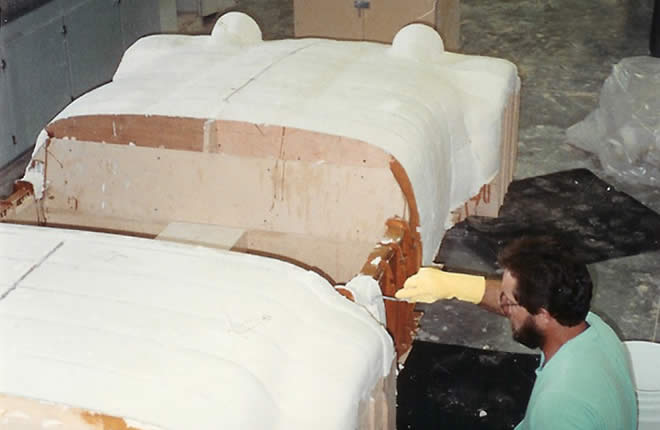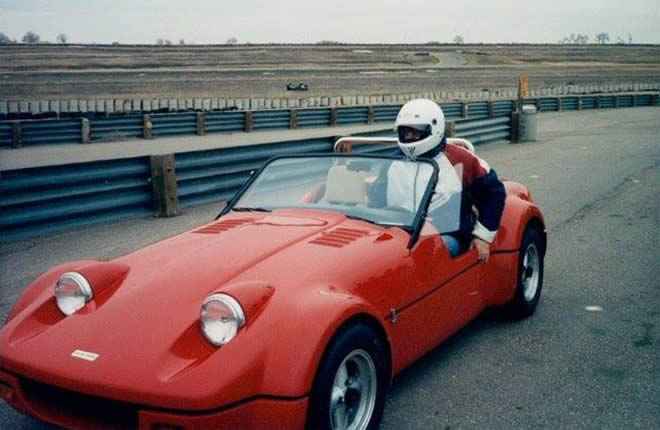Maxton had a short run as car companies go, about three years, and in that time fifty production Rollerskates were built. Despite rave reviews from Road & Track magazine, the public was not particularly interested in a near $25K component car from an unknown company in Colorado. Those who saw and drove the Rollerskate recognized the quality and value, but Maxton was unable to get that message out to the market.

The story, though, began a half dozen year earlier. For some time an idea had been germinating in the mind of Bob Sutherland. A wealthy businessman, he was a longtime vintage car enthusiast and collector, enjoying success at the Monterey Historic Races and the Concours de Elegance at Pebble Beach. His love of classic racing and sports cars fed his desire to build a roadster reminiscent of the classic British sports cars of the early sixties. He wanted a car that would recall the Lotus Seven, the original bugeye Sprite, the Ginetta G4, etc. But he wanted it to have truly modern performance. No BMC or Ford power trains, the Maxton was designed around the most modern power plant in the world, the rotary engine from the first-generation Mazda RX-7.

Getting from that vision to the reality would take some skills Bob did not have. Knowing what he was looking for, he assembled a small group of talented people and charged them with engineering the Maxton. Why the Maxton name? Well, it just sounded right. The Maxton team consisted of four men, Bob was the visionary, the driving force, and of course, provided the financing. Michael Mate, a talented local artist was enlisted for the body design. Ben van der Linden, an experienced race car engineer, designed the tubular space frame, onto which Gary Valler grafted the independent front A-arm suspension utilizing Mustang II Spindles and disc brakes. The entire drive train would be lifted essentially intact from the first-generation RX-7, and with a target weight of the Rollerskate of 1500 pounds.

With the design complete, Sutherland turned to a small shop in Colorado Springs to weld up a prototype frame. By June 1989 an unbodied, but running chassis was complete. Sutherland and the others drove it. One such “tester” was Dan Ripley. Impressed, the former SCCA racer came to an agreement with Sutherland that he would head up what was soon to be an automobile manufacturing company. A word here about that company. From the beginning, all concerned understood that given Federal safety and emissions regulations, the Maxton would have to be a component car. Note that it was not to be a “Kit Car”. Rather the plan was for Maxton Components to assemble the body/chassis unit, while local contractors would independently install refurbished mechanicals, paint the bodywork, and upholster the interior.

But before becoming a manufacturer, there was more work required. Ben van der Linden and welder Jeff Novotny built a set of chassis jigs. Another frame was built up on these jigs and the mechanicals from the first prototype were transferred into what was now called chassis P2. In the spring of 1990, Walter Thurner of CF Maier Composites of Lamar, Colorado created a set of molds from Mate’s design, and the first pre-production body was made and fitted to the chassis.

Over the next year, P2 was not only the company’s test bed, but also its demonstrator. It ran in the first “Colorado Grand” 1000-mile rally (another vision that Sutherland brought to fruition), garnering significant positive publicity for its trouble free run. Pictures of this prototype appeared in company brochures and enthusiasts publications. In July 1991 the final production version of the body replaced the first body. The now bright red car became the Maxton’s full time demonstrator. This and all subsequent Rollerskate bodies were made by Walter Thurner.

P3, the final prototype, was probably the most storied of all Maxtons. This car was constructed by the staff of the PBS Motorweek TV program (with some help from the Maxton staff) during 1991. After finishing it in British Racing Green, a drawing was held in the fall. Some 900,000 entries were received, with the winners being Monte and Chris Payton of Long Key, FL. The PBS crew trailered the car from Maryland and filmed the delivery for another episode. The PBS archives are reputed to still contain tapes of the Maxton shows. Apparently the Payton’s were not “gearheads” as they decided to part with the car. An enthusiast with connections to Motorweek quickly snapped it up and owns it to this day. Pat Goss, one of the Motorweek hosts, has been quoted as saying the Maxton Rollerskate was his favorite car of all he has driven in his years on the show.

Finally, the Maxton was ready for prime time. The Englewood factory was set up, the jigs and body molds were ready. Autoweek and Grassroots Motorsport had published very favorable reviews in late 1992 and allied with the publicity from the Motorweek TV series, there was every expectation that sales would follow. Unfortunately for Bob and the Maxton staff, the economy slipped into a recession. Suddenly, classic cars, such as the Ferrari GTO, that had been selling for ten million dollars could be had for half that price. The recession effected the sales of many performance cars across the market. With only a few sales and a number of Rollerskates “in the pipeline” at the factory, Bob Sutherland hit upon the idea of awarding many of the cars to his managers at the various Sutherland Lumber Company stores as a bonus for their years of loyal service.

Finally, the Maxton was ready for prime time. The Englewood factory was set up, the jigs and body molds were ready. Autoweek and Grassroots Motorsport had published very favorable reviews in late 1992 and allied with the publicity from the Motorweek TV series, there was every expectation that sales would follow. Unfortunately for Bob and the Maxton staff, the economy slipped into a recession. Suddenly, classic cars, such as the Ferrari GTO, that had been selling for ten million dollars could be had for half that price. The recession effected the sales of many performance cars across the market. With only a few sales and a number of Rollerskates “in the pipeline” at the factory, Bob Sutherland hit upon the idea of awarding many of the cars to his managers at the various Sutherland Lumber Company stores as a bonus for their years of loyal service.

The Maxton story does not quite end there. After falling in price for many years, the cars are now increasing in value as they find more appreciative second or third owners. Owners that understand how well the cars were designed and built and how much potential there is to increase the performance even more and how the car provides a truly unique and” pure driving experience”.

